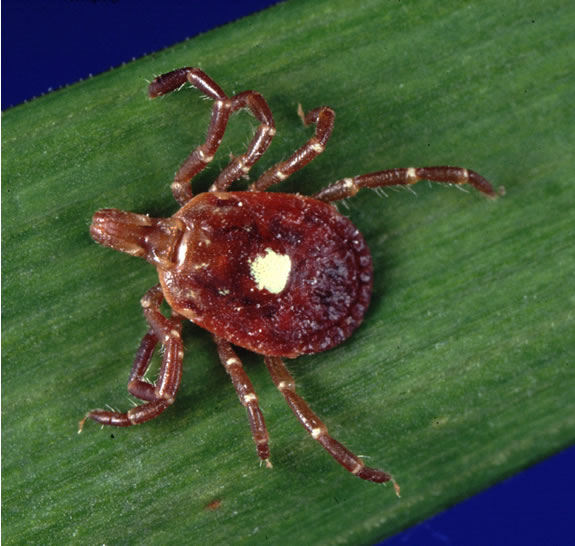Amblyomma americanum, Lone Star tick, is capable of transmitting several human and zoonotic pathogens. The species is currently (as of the paper, 2016) has a known distribution of the Southern and Eastern United States, with some eastern parts of Kansas within the range. However, there is increasing evidence that the species is also located in western areas of Kansas and diseases caused by the transmittable pathogens also occurring. The authors intend to update the predicted distribution of the species across the Kansas landscape using MaxEnt.
 Female adult lone star tick (Amblyomma americanum)
Female adult lone star tick (Amblyomma americanum)
Known occurrence data of the species was obtained from three sources providing historical and current surveys. Environmental data was gathered from CliMond. This set provides more data, such as soil moisture, that is more biologically relevant to the tick species. To remove autocorrelation between predictor variables, the Band Collection Statistics tool (ArcGIS) was used to exclude pairs of highly correlated variables. Lastly, PCA was used on the predictor CliMond variables and standardized components of a reduced dimensionality were used in the MaxEnt model.
From the results of the PCA, ~88% of the variation in the was explained by the first two principle components. The first consisted mainly of soil moisture and temperature variables (61.4%) and the second consisting mostly of precipitation (26.4%). The MaxEnt model resulted in a best fit AUC of 0.84. The easternmost regions of Kansas provided the highest suitability of the species with a decrease going westward (Featured Image). However, there are some regions in the west that are suitable for the species. These results are of a wider range that currently(previously) predicted. The authors then go into discussion how the climatic variables included in the model may affect the behavior/ecology of the ticks particularly interspecies interactions and questing behaviors. With this increase in potential range, the risk for pathogen transmission also becomes worrisome. The authors close by commenting on the potential impact that climate change can have on the distribution/potential distribution of the species.
Raghavan, R. K., Goodin, D. G., Hanzlicek, G. A., Zolnerowich, G., Dryden, M. W., Anderson, G. A. & Ganta, R. R. 2016 Maximum Entropy-Based Ecological Niche Model and Bio-Climatic Determinants of Lone Star Tick (Amblyomma americanum) Niche. Vector-Borne Zoonotic Dis. 16, 205–211.

